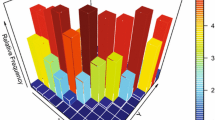Abstract
In the previous chapter, we asked how strongly two interval-level variables were correlated. In this chapter, we ask a related question that is central to much statistical analysis in criminology and criminal justice: Can we predict the level of one interval-level variable from the value of another? As in the description of specific measures of association for nominal and ordinal variables in Chapter 13, in regression analysis we must define which variable is the independent variable, or predictor variable, and which variable is the dependent variable, or the variable being predicted. We also introduce the idea of regression modeling in this chapter. our discussion focuses on how regression analysis is used to create a prediction model and the statistics that researchers use to evaluate such models.
Access this chapter
Tax calculation will be finalised at checkout
Purchases are for personal use only
Similar content being viewed by others
Notes
- 1.
Jihong Zhao and Quint Thurman, "A National Evaluation of the Effect of COPS Grants on Crime from 1994-1999," unpublished manuscript, University of Nebraska, December, 2001.
- 2.
Note that there is no single accepted convention for representing the Y-intercept. Some researchers use the symbol α (alpha), while others prefer to use a.
- 3.
For a discussion of the relationship between age and crime, see David F. Farrington, "Age and Crime," in Crime and Justice: An Annual Review of Research, Vol. 7 (Chicago: University of Chicago Press, 1986), pp. 189-250.
- 4.
In the case of multivariate regression analysis (described in detail in Chapter 16), where there are multiple independent variables, some statisticians advise using an adjusted measure of R 2. Commonly referred to as adjusted R 2, it is routinely provided by most statistical software programs. Adjusted R 2 is calculated using the following formula:
$${\rm{Adjusted }}\ R^2 = 1 - \left( {1 - R^2 } \right)\left( {\frac{{N - 1}}{{N - k - 1}}} \right)$$where к equals the number of independent variables and N is the number of observations in the sample.
djused R 2 can prevent a misleading interpretation of the strength of prediction of a model, because it offsets the artificial inflation in the statistic that is created with every additional variable added to a regression model. Nonetheless, the adjustment represents a transformation of the R 2 value and thus alters the simple meaning of the statistic. We do not advise using the adjusted R 2 value unless it differs substantially from the simple R 2 value.
- 5.
It is important to note that this equation for the standard error of b is appropriate only if we have a bivariate regression model. If we have two or more independent variables, then a modified equation is necessary to calculate the standard error of the regression coefficients.
- 6.
Except for rounding error, this result is the same as the one we obtained in testing the significance of the correlation coefficient for this relationship (4.4195 vs. 4.4188). In practice, you could use the correlation coefficient significance test result for defining the statistical significance of the regression coefficient. Indeed, in many texts only one formula is provided for both coefficients.
- 7.
While we do not state the assumption of the tests below formally, they follow those discussed in the prior section. We assume an interval scale, a normal distribution (relaxed when N is large), homoscedasticity, linearity, and independent random sampling.
- 8.
We have likely violated the normality assumption of our test because we do not have knowledge about the shape of the joint distribution of age and number of arrests in the population and N = 15 cases is not enough to safely invoke the central limit theorem.
Author information
Authors and Affiliations
Rights and permissions
Copyright information
© 2014 Springer Science+Business Media New York
About this chapter
Cite this chapter
Weisburd, D., Britt, C. (2014). An Introduction to Bivariate Regression. In: Statistics in Criminal Justice. Springer, Boston, MA. https://doi.org/10.1007/978-1-4614-9170-5_15
Download citation
DOI: https://doi.org/10.1007/978-1-4614-9170-5_15
Published:
Publisher Name: Springer, Boston, MA
Print ISBN: 978-1-4614-9169-9
Online ISBN: 978-1-4614-9170-5
eBook Packages: Humanities, Social Sciences and LawSocial Sciences (R0)




